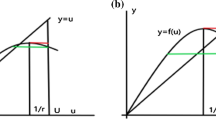Abstract
Integrodifference equations are a class of infinite-dimensional dynamical systems in discrete time that have recently received great attention as mathematical models of population dynamics in spatial ecology. The dispersal of individuals between generations is described by a ‘dispersal kernel’, a probability density function for the distance that an individual moves within a season. Previous authors recognized that the dynamics are reduced to a finite-dimensional problem when the dispersal kernel is separable. We prove some open questions from their work on the dynamics of a single population and then extend the idea to investigate the dynamics of two spatially distributed species in (i) a competitive relation, and (ii) a predator-prey relation. In all cases, we discuss how the dynamics of the population(s) depend on the amount of suitable space that is available to them. We find a number of bifurcations, such as period-doubling sequences and Naimark-Sacker bifurcations, which we illustrate through simulations.








Similar content being viewed by others
References
Allen, E., Allen, L., Gilliam, X.: Dispersal and competition models for plants. J. Math. Biol. 34, 455–481 (1996)
Cantrell, R.S., Cosner, C.: Spatial Ecology Via Reaction-Diffusion Equations. Mathematical and Computational Biology. Wiley, New York (2003)
Cobbold, C., Lewis, M., Lutscher, F., Roland, J.: How parasitism affects critical patch size in a host-parasitoid system: application to Forest Tent Caterpillar. Theor. Popul. Biol. 67(2), 109–125 (2005)
Day, S., Junge, O., Mischaikow, K.: A rigerous numerical method for the global dynamics of infinite-dimensional discrete dynamical systems. SIAM J. Appl. Dyn. Syst. 3(2), 117–160 (2004)
Day, S., Kalies, W.D.: Rigorous computation of the global dynamics of integrodifference equations with smooth nonlinearities. SIAM J. Numer. Anal. 51(6), 2957–2983 (2013)
Durrett, R.: Mutual Invadability Implies Coexistence in Spatial Models. Am. Math. Soc., Providence (2002)
Fagan, W., Lutscher, F.: The average dispersal success approximation: a bridge linking home range size, natal dispersal, and metapopulation dynamics to critical patch size and reserve design. Ecol. Appl. 16(2), 820–828 (2006)
Jury, E.: Inners and Stability of Dynamic Systems. Wiley, New York (1974)
Kot, M.: Diffusion-driven period-doubling bifurcations. Biosystems 22, 279–287 (1989)
Kot, M., Schaffer, W.M.: Discrete-time growth-dispersal models. Math. Biosci. 80, 109–136 (1986)
Latore, J., Gould, P., Mortimer, A.: Spatial dynamics and critical patch size of annual plant populations. J. Theor. Biol. 190, 277–285 (1998)
Lutscher, F.: Density-dependent dispersal in integrodifference equations. J. Math. Biol. 56(4), 499–524 (2008)
Lutscher, F., Lewis, M.: Spatially-explicit matrix models. A mathematical analysis of stage-structured integrodifference equations. J. Math. Biol. 48, 293–324 (2004)
May, M.: Stability and Complexity in Model Ecosystems. Princeton University Press, Princeton (1973)
Neubert, M., Kot, M.: The subcritical collapse of predator populations in discrete time predator-prey models. Math. Biosci. 110, 45–66 (1992)
Neubert, M., Kot, M., Lewis, M.A.: Dispersal and pattern formation in a discrete-time predator-prey model. Theor. Popul. Biol. 48(1), 7–43 (1995)
Skellam, J.G.: Random dispersal in theoretical populations. Biometrika 38, 196–218 (1951)
Van Kirk, R.W.: Integrodifference models for biological growth and dispersal. Ph.D. thesis, University of Utah (1995)
Van Kirk, R.W., Lewis, M.A.: Integrodifference models for persistence in fragmented habitats. Bull. Math. Biol. 59(1), 107–137 (1997)
Author information
Authors and Affiliations
Corresponding author
Rights and permissions
About this article
Cite this article
Bramburger, J., Lutscher, F. Analysis of Integrodifference Equations with a Separable Dispersal Kernel. Acta Appl Math 161, 127–151 (2019). https://doi.org/10.1007/s10440-018-0207-9
Received:
Accepted:
Published:
Issue Date:
DOI: https://doi.org/10.1007/s10440-018-0207-9




